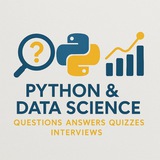❓ Interview question :
What is the Transformer architecture, and why is it considered a breakthrough in NLP?
❓ Interview question :
How does self-attention enable Transformers to capture long-range dependencies in text?
❓ Interview question :
What are the main components of a Transformer model?
❓ Interview question :
Why are positional encodings essential in Transformers?
❓ Interview question :
How does multi-head attention improve Transformer performance compared to single-head attention?
❓ Interview question :
What is the purpose of feed-forward networks in the Transformer architecture?
❓ Interview question :
How do residual connections and layer normalization contribute to training stability in Transformers?
❓ Interview question :
What is the difference between encoder and decoder in the Transformer model?
❓ Interview question :
Why can Transformers process sequences in parallel, unlike RNNs?
❓ Interview question :
How does masked self-attention work in the decoder of a Transformer?
❓ Interview question :
What is the role of key, query, and value in attention mechanisms?
❓ Interview question :
How do attention weights determine which parts of input are most relevant?
❓ Interview question :
What are the advantages of using scaled dot-product attention in Transformers?
❓ Interview question :
How does position-wise feed-forward network differ from attention layers in Transformers?
❓ Interview question :
Why is pre-training important for large Transformer models like BERT and GPT?
❓ Interview question :
How do fine-tuning and transfer learning benefit Transformer-based models?
❓ Interview question :
What are the limitations of Transformers in terms of computational cost and memory usage?
❓ Interview question :
How do sparse attention and linear attention address scalability issues in Transformers?
❓ Interview question :
What is the significance of model size (e.g., number of parameters) in Transformer performance?
❓ Interview question :
How do attention heads in multi-head attention capture different types of relationships in data?
#️⃣ tags: #Transformer #NLP #DeepLearning #SelfAttention #MultiHeadAttention #PositionalEncoding #FeedForwardNetwork #EncoderDecoder
By: t.iss.one/DataScienceQ 🚀
What is the Transformer architecture, and why is it considered a breakthrough in NLP?
❓ Interview question :
How does self-attention enable Transformers to capture long-range dependencies in text?
❓ Interview question :
What are the main components of a Transformer model?
❓ Interview question :
Why are positional encodings essential in Transformers?
❓ Interview question :
How does multi-head attention improve Transformer performance compared to single-head attention?
❓ Interview question :
What is the purpose of feed-forward networks in the Transformer architecture?
❓ Interview question :
How do residual connections and layer normalization contribute to training stability in Transformers?
❓ Interview question :
What is the difference between encoder and decoder in the Transformer model?
❓ Interview question :
Why can Transformers process sequences in parallel, unlike RNNs?
❓ Interview question :
How does masked self-attention work in the decoder of a Transformer?
❓ Interview question :
What is the role of key, query, and value in attention mechanisms?
❓ Interview question :
How do attention weights determine which parts of input are most relevant?
❓ Interview question :
What are the advantages of using scaled dot-product attention in Transformers?
❓ Interview question :
How does position-wise feed-forward network differ from attention layers in Transformers?
❓ Interview question :
Why is pre-training important for large Transformer models like BERT and GPT?
❓ Interview question :
How do fine-tuning and transfer learning benefit Transformer-based models?
❓ Interview question :
What are the limitations of Transformers in terms of computational cost and memory usage?
❓ Interview question :
How do sparse attention and linear attention address scalability issues in Transformers?
❓ Interview question :
What is the significance of model size (e.g., number of parameters) in Transformer performance?
❓ Interview question :
How do attention heads in multi-head attention capture different types of relationships in data?
#️⃣ tags: #Transformer #NLP #DeepLearning #SelfAttention #MultiHeadAttention #PositionalEncoding #FeedForwardNetwork #EncoderDecoder
By: t.iss.one/DataScienceQ 🚀
❤2
